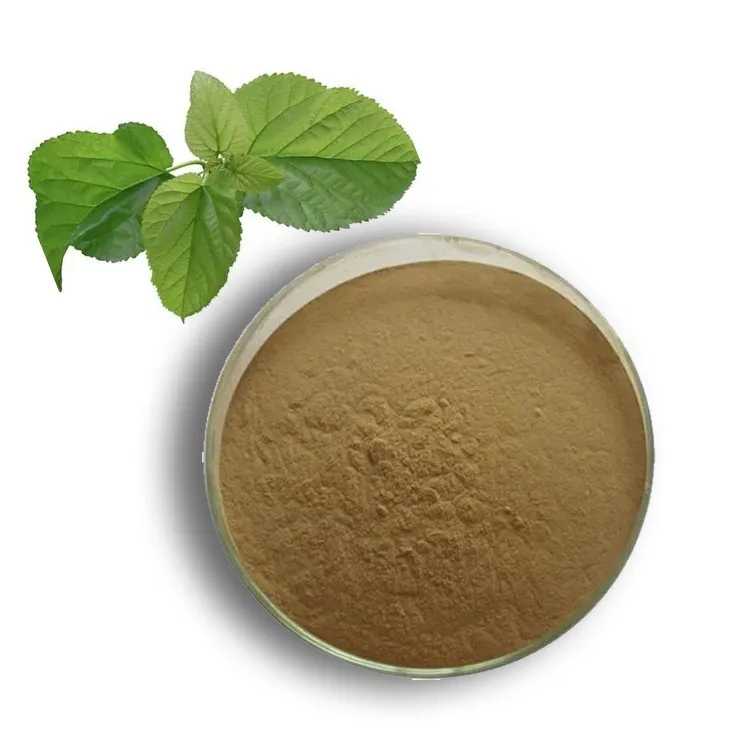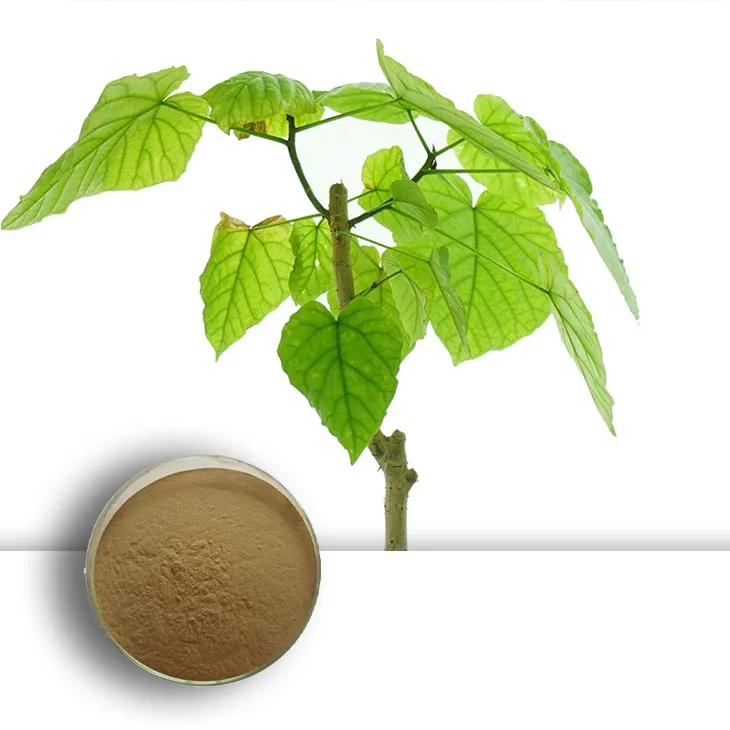- 0086-571-85302990
- sales@greenskybio.com
Active components in mulberry leaf extracts.
2024-11-29

1. Introduction
Mulberry leaves have been used in traditional medicine for centuries. With the development of modern scientific research, the active components in Mulberry leaf Extracts have attracted increasing attention. These active components are responsible for a variety of potential health benefits, making Mulberry leaf Extracts a promising candidate in the fields of healthcare, pharmaceuticals, and even the food industry.

2. Sterols in Mulberry leaf Extracts
Sterols are one of the important active components in mulberry leaf extracts. They play a significant role in influencing cholesterol levels.
2.1 Structure and Types of Sterols
Mulberry leaf sterols are structurally diverse. They belong to the family of plant sterols, which are similar in structure to cholesterol but have different physiological functions. Common sterols found in mulberry leaves include beta - sitosterol, campesterol, and stigmasterol. Beta - sitosterol, for example, is one of the most abundant sterols. It has a chemical structure that allows it to interact with cholesterol in the body.
2.2 Effects on Cholesterol Levels
The sterols in mulberry leaf extracts may have beneficial effects on cholesterol levels. They can compete with cholesterol for absorption in the intestines. When consumed, they can reduce the amount of dietary cholesterol that is absorbed into the bloodstream. This mechanism helps in lowering the overall cholesterol levels in the body, particularly the low - density lipoprotein (LDL) cholesterol, which is often referred to as "bad" cholesterol.

3. Proteins and Peptides in Mulberry Leaf Extracts
Another group of important active components in mulberry leaf extracts are proteins and peptides. These molecules are involved in various biological activities.
3.1 Antioxidant Activity
The proteins and peptides in mulberry leaf extracts can exhibit antioxidant activities. Oxidative stress is a major factor contributing to many chronic diseases. Antioxidants are substances that can neutralize free radicals, which are unstable molecules that can damage cells. The antioxidant activity of these proteins and peptides helps in protecting the body's cells from oxidative damage. They can scavenge free radicals, preventing them from causing harm to cellular components such as DNA, proteins, and lipids.
3.2 Antihypertensive Activity
Some of the proteins and peptides in mulberry leaf extracts also show antihypertensive activities. High blood pressure is a common health problem that can lead to serious cardiovascular diseases. These proteins and peptides can act on the renin - angiotensin - aldosterone system (RAAS), which is an important regulator of blood pressure. By interfering with this system, they can help in reducing blood pressure levels. For example, certain peptides may inhibit the activity of angiotensin - converting enzyme (ACE), which is involved in the production of a hormone that constricts blood vessels.

4. Volatile Oils in Mulberry Leaf Extracts
Although present in small amounts, volatile oils also contribute to the overall properties of mulberry leaf extracts.
4.1 Composition of Volatile Oils
The volatile oils in mulberry leaves are composed of a complex mixture of organic compounds. These include terpenes, esters, alcohols, and aldehydes. Each of these components may have its own unique properties and potential biological activities. For example, some terpenes may have antimicrobial or anti - inflammatory properties.
4.2 Their Contribution to the Extract
The volatile oils can contribute to the aroma and flavor of the mulberry leaf extract. In addition to their sensory properties, they may also play a role in the biological activities of the extract. Although more research is needed to fully understand their specific functions, their presence is an important part of the overall composition of the mulberry leaf extract.
5. Other Active Components
Besides sterols, proteins/peptides, and volatile oils, mulberry leaf extracts may also contain other active components.
5.1 Flavonoids
Flavonoids are a class of polyphenolic compounds that are widely distributed in plants, including mulberry leaves. They are known for their antioxidant, anti - inflammatory, and anti - cancer properties. In mulberry leaves, flavonoids such as rutin and Quercetin are present. These flavonoids can scavenge free radicals, reduce inflammation in the body, and may have potential anti - cancer effects through various mechanisms, such as inhibiting cell proliferation and inducing apoptosis in cancer cells.
5.2 Alkaloids
Mulberry leaves also contain alkaloids, which are nitrogen - containing organic compounds. Although the exact functions of alkaloids in mulberry leaf extracts are still being investigated, some alkaloids in other plants have been shown to have biological activities such as analgesic, anti - microbial, and anti - hypertensive effects. It is possible that the alkaloids in mulberry leaves may also contribute to the overall health - promoting properties of the extract.
6. Potential Applications in Healthcare
The active components in mulberry leaf extracts have several potential applications in healthcare.
6.1 Cardiovascular Health
Given the cholesterol - lowering effects of sterols and the antihypertensive activities of proteins/peptides, mulberry leaf extracts may be beneficial for cardiovascular health. By reducing LDL cholesterol levels and blood pressure, they can help in reducing the risk of heart disease and stroke.
6.2 Anti - Diabetic Properties
Some studies have suggested that mulberry leaf extracts may have anti - diabetic properties. The various active components, such as flavonoids and alkaloids, may work together to regulate blood sugar levels. They may improve insulin sensitivity, promote glucose uptake by cells, and inhibit the breakdown of carbohydrates in the intestine, all of which can contribute to better blood sugar control.
6.3 Anti - Inflammatory Effects
The antioxidant and anti - inflammatory properties of components like flavonoids and proteins/peptides make mulberry leaf extracts potentially useful in treating inflammatory diseases. Inflammation is a key factor in many chronic diseases, such as arthritis, and the use of mulberry leaf extracts may help in reducing inflammation and alleviating symptoms.
7. Applications in Other Industries
Mulberry leaf extracts are not only useful in healthcare but also have potential applications in other industries.
7.1 Food Industry
In the food industry, mulberry leaf extracts can be used as a natural additive. The antioxidant properties of the extract can help in preventing the oxidation of fats and oils in food products, thereby increasing their shelf life. Additionally, the presence of flavonoids and other bioactive components may also add nutritional value to food products. For example, it can be added to beverages, baked goods, or functional foods.
7.2 Cosmetic Industry
The antioxidant and anti - inflammatory properties of mulberry leaf extracts also make them suitable for use in the cosmetic industry. They can be incorporated into skincare products such as creams, lotions, and serums. These extracts can help in protecting the skin from oxidative damage, reducing inflammation, and improving skin health. For example, they may be used to reduce wrinkles, improve skin elasticity, and treat skin conditions such as acne and eczema.
8. Conclusion
In conclusion, mulberry leaf extracts contain a variety of active components, including sterols, proteins/peptides, volatile oils, flavonoids, and alkaloids. These components are responsible for a range of potential health benefits and have applications in healthcare, food, and cosmetic industries. However, more research is still needed to fully understand the mechanisms of action of these components and to optimize their use. With further research, mulberry leaf extracts may become an important source of natural bioactive compounds for various applications.
FAQ:
What are the main active components in mulberry leaf extracts?
The main active components in mulberry leaf extracts include sterols, proteins and peptides, and small amounts of volatile oils. Sterols may have an impact on cholesterol levels. Proteins and peptides can show antioxidant and antihypertensive activities, and volatile oils contribute to the overall properties of the extract.
How do sterols in mulberry leaf extracts affect cholesterol levels?
While the exact mechanisms are still under study, sterols in mulberry leaf extracts may interact with cholesterol in the body. They might interfere with the absorption of dietary cholesterol in the intestines, which could potentially lead to a reduction in overall cholesterol levels in the body.
What antioxidant activities do the proteins and peptides in mulberry leaf extracts exhibit?
The proteins and peptides in mulberry leaf extracts can scavenge free radicals. They may act as reducing agents, donating electrons to stabilize free radicals, thereby preventing oxidative damage to cells and tissues. This antioxidant activity is important for maintaining overall health and may have implications in preventing various diseases related to oxidative stress.
How can the antihypertensive activities of proteins and peptides in mulberry leaf extracts be explained?
The antihypertensive activities of proteins and peptides in mulberry leaf extracts could be due to multiple factors. They may interact with the renin - angiotensin - aldosterone system, which plays a crucial role in blood pressure regulation. By modulating this system, they can potentially lead to a reduction in blood pressure. Additionally, they might also have an effect on blood vessel relaxation, contributing to the antihypertensive effect.
What is the role of volatile oils in mulberry leaf extracts?
The volatile oils in mulberry leaf extracts, although present in small amounts, contribute to the overall properties of the extract. They may play a role in the characteristic aroma of the extract. Moreover, they could potentially have some biological activities that interact with other components in the extract, enhancing the overall functionality of the mulberry leaf extract.
Related literature
- Analysis of Active Components in Mulberry Leaf Extracts and Their Potential Health Benefits"
- "The Chemical Composition and Bioactive Properties of Mulberry Leaf Extracts"
- ▶ Hesperidin
- ▶ Citrus Bioflavonoids
- ▶ Plant Extract
- ▶ lycopene
- ▶ Diosmin
- ▶ Grape seed extract
- ▶ Sea buckthorn Juice Powder
- ▶ Fruit Juice Powder
- ▶ Hops Extract
- ▶ Artichoke Extract
- ▶ Mushroom extract
- ▶ Astaxanthin
- ▶ Green Tea Extract
- ▶ Curcumin
- ▶ Horse Chestnut Extract
- ▶ Other Product
- ▶ Boswellia Serrata Extract
- ▶ Resveratrol
- ▶ Marigold Extract
- ▶ Grape Leaf Extract
- ▶ New Product
- ▶ Aminolevulinic acid
- ▶ Cranberry Extract
- ▶ Red Yeast Rice
- ▶ Red Wine Extract
-
Lemon Balm Extract
2024-11-29
-
Citrus Aurantii Extract
2024-11-29
-
Acai Berry Extract
2024-11-29
-
Acerola Extract
2024-11-29
-
Alisma Extract
2024-11-29
-
Phyllanthus Emblica Extract
2024-11-29
-
Rose Hip Extract
2024-11-29
-
Lavender Extract
2024-11-29
-
Eyebright Extract
2024-11-29
-
Andrographis Paniculata Extract Powder
2024-11-29





















